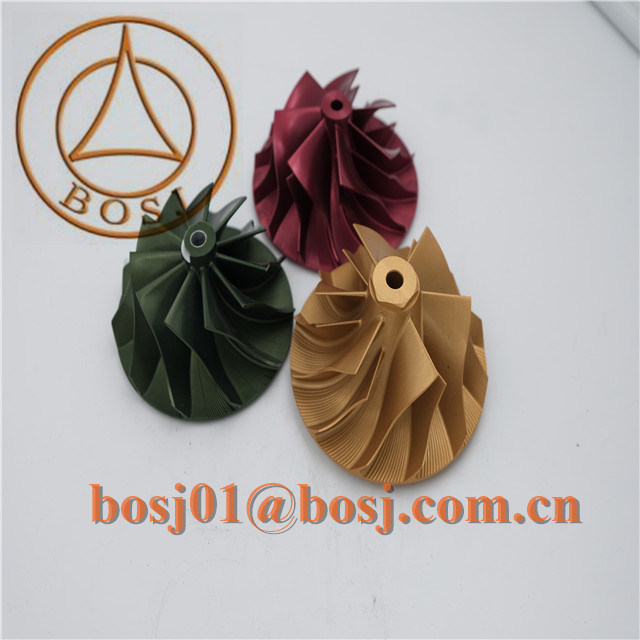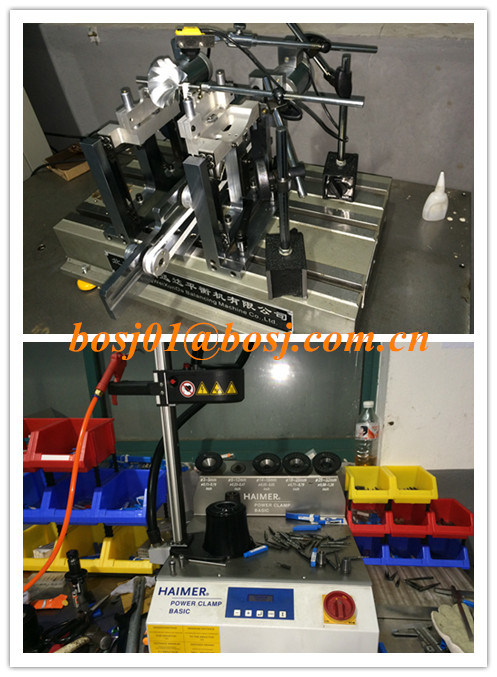
Energy provided for the turbine work is converted from the enthalpy and kinetic energy of the gas. The turbine housings direct the gas flow through the turbine as it spins at up to 250,000 rpm. TheÂ
Â
size and shape can dictate some performance characteristics of the overall turbocharger. Often the same basic turbocharger assembly is available from the manufacturer with multiple housing choicesÂ
Â
for the turbine, and sometimes the compressor cover as well. This lets the balance between performance, response, and efficiency be tailored to the application.
Â
The turbine and impeller wheel sizes also dictate the amount of air or exhaust that can be flowed through the system, and the relative efficiency at which they operate. In general, the larger theÂ
Â
turbine wheel and compressor wheel the larger the flow capacity. Measurements and shapes can vary, as well as curvature and number of blades on the wheels.
 Â
Compressor Wheel Parameter
Application
Replace wheel number: ???
Fit CHRA :Â 700177-0001
Fit Turbo #Â : 714569-0001, 714569-0002, 714569-0003
Product Situation
Brand New
Maximum boost 5Â bar /Â 70 Psi
Balance
Balanced By SCHENCK Germany
Ready to competition
Wheel Size
Inducer Dia.: 54.97 /Â 76.13 mm (Trim 52)
Exducer Dia. :Â 76.13 mm
Extend Tapered Tip Exducer dia :Â 82.54 mm
Tip Height: 6.55 mm
Super Back Height: 2.36 mm
Bore: 5.99 mm
Blade :Â 6+6
Material
Forged Aluminum
 Note
We can customize billet compressor wheel, Please contact us if you need it.
We can combine shipping for all items and will send invoice when we receive all of your order.
On the left, the brass oil drain connection. On the right are the braided oil supply line and water coolant line connections.
Â
Compressor impeller side with the cover removed.
 
Compressor Precision Machine
The compressor increases the mass of intake air entering the combustion chamber. The compressor is made up of an impeller, a diffuser and a volute housing.
Main article: Centrifugal compressor
The operating range of a compressor is described by the "compressor map".
Â
Main article: Compressor map
  Additional technologies commonly used in turbocharger installations
Intercooling[edit]
 
Â
Compress WheelÂ
In this situation, the surge can raise the pressure of the air to a level that can cause damage. This is because if the pressure rises high enough, a compressor stall occurs-stored pressurized air decompresses backward across the impeller and out the inlet. The reverse flow back across the turbocharger makes the turbine shaft reduce in speed more quickly than it would naturally, possibly damaging the turbocharger.
Â
To prevent this from happening, a valve is fitted between the turbocharger and inlet, which vents off the excess air pressure. These are known as an anti-surge, diverter, bypass, turbo-relief valve, blow-off valve (BOV), or dump valve. It is a pressure relief valve, and is normally operated by the vacuum in the intake manifold.
Â
The primary use of this valve is to maintain the spinning of the turbocharger at a high speed. The air is usually recycled back into the turbocharger inlet (diverter or bypass valves), but can also be vented to the atmosphere (blow off valve). Recycling back into the turbocharger inlet is required on an engine that uses a mass-airflow fuel injection system, because dumping the excessive air overboard downstream of the mass airflow sensor causes an excessively rich fuel mixture-because the mass-airflow sensor has already accounted for the extra air that is no longer being used. Valves that recycle the air also shorten the time needed to re-spool the turbocharger after sudden engine deceleration, since load on the turbocharger when the valve is active is much lower than if the air charge vents to atmosphere.
 
For more details,please contact me.
Joyce
Â
Â
Turbine Compressor Wheel
Energy provided for the turbine work is converted from the enthalpy and kinetic energy of the gas. The turbine housings direct the gas flow through the turbine as it spins at up to 250,000 rpm. TheÂ
Â
size and shape can dictate some performance characteristics of the overall turbocharger. Often the same basic turbocharger assembly is available from the manufacturer with multiple housing choicesÂ
Â
for the turbine, and sometimes the compressor cover as well. This lets the balance between performance, response, and efficiency be tailored to the application.
Â
The turbine and impeller wheel sizes also dictate the amount of air or exhaust that can be flowed through the system, and the relative efficiency at which they operate. In general, the larger theÂ
Â
turbine wheel and compressor wheel the larger the flow capacity. Measurements and shapes can vary, as well as curvature and number of blades on the wheels.
 Â
Compressor Wheel Parameter
Application
Replace wheel number: ???
Fit CHRA :Â 700177-0001
Fit Turbo #Â : 714569-0001, 714569-0002, 714569-0003
Product Situation
Brand New
Maximum boost 5Â bar /Â 70 Psi
Balance
Balanced By SCHENCK Germany
Ready to competition
Wheel Size
Inducer Dia.: 54.97 /Â 76.13 mm (Trim 52)
Exducer Dia. :Â 76.13 mm
Extend Tapered Tip Exducer dia :Â 82.54 mm
Tip Height: 6.55 mm
Super Back Height: 2.36 mm
Bore: 5.99 mm
Blade :Â 6+6
Material
Forged Aluminum
 Note
We can customize billet compressor wheel, Please contact us if you need it.
We can combine shipping for all items and will send invoice when we receive all of your order.
On the left, the brass oil drain connection. On the right are the braided oil supply line and water coolant line connections.
Â
Compressor impeller side with the cover removed.
 
Compressor Precision Machine
The compressor increases the mass of intake air entering the combustion chamber. The compressor is made up of an impeller, a diffuser and a volute housing.
Main article: Centrifugal compressor
The operating range of a compressor is described by the "compressor map".
Â
Main article: Compressor map
  Additional technologies commonly used in turbocharger installations
Intercooling[edit]
 
Â
Compress WheelÂ
In this situation, the surge can raise the pressure of the air to a level that can cause damage. This is because if the pressure rises high enough, a compressor stall occurs-stored pressurized air decompresses backward across the impeller and out the inlet. The reverse flow back across the turbocharger makes the turbine shaft reduce in speed more quickly than it would naturally, possibly damaging the turbocharger.
Â
To prevent this from happening, a valve is fitted between the turbocharger and inlet, which vents off the excess air pressure. These are known as an anti-surge, diverter, bypass, turbo-relief valve, blow-off valve (BOV), or dump valve. It is a pressure relief valve, and is normally operated by the vacuum in the intake manifold.
Â
The primary use of this valve is to maintain the spinning of the turbocharger at a high speed. The air is usually recycled back into the turbocharger inlet (diverter or bypass valves), but can also be vented to the atmosphere (blow off valve). Recycling back into the turbocharger inlet is required on an engine that uses a mass-airflow fuel injection system, because dumping the excessive air overboard downstream of the mass airflow sensor causes an excessively rich fuel mixture-because the mass-airflow sensor has already accounted for the extra air that is no longer being used. Valves that recycle the air also shorten the time needed to re-spool the turbocharger after sudden engine deceleration, since load on the turbocharger when the valve is active is much lower than if the air charge vents to atmosphere.
 
For more details,please contact me.
Joyce
Â
Â
New Billet Turbine Compressor Wheel K16 Turbo 53241232032 for Kkk Turbocharger Parts of Auto Engine
Model NO.: BOSJ-S
Application: WuLing
Brand: Garrett
Making Machine: 5 Axis
Trademark: BOSJ
Specification: BOSJ-T
Origin: Jiangsu
Model NO.: BOSJ-S
Application: WuLing
Brand: Garrett
Making Machine: 5 Axis
Trademark: BOSJ
Specification: BOSJ-T
Origin: Jiangsu
Turbine Compressor Wheel